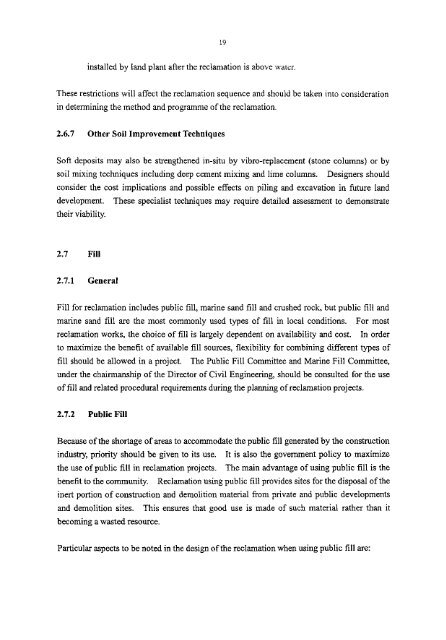PORT WORKS DESIGN MANUAL PART 3 Guide To - The University ...
PORT WORKS DESIGN MANUAL PART 3 Guide To - The University ...
PORT WORKS DESIGN MANUAL PART 3 Guide To - The University ...
Create successful ePaper yourself
Turn your PDF publications into a flip-book with our unique Google optimized e-Paper software.
19installed by land plant after the reclamation is above water.<strong>The</strong>se restrictions will affect the reclamation sequence and should be taken into considerationin determining the method and programme of the reclamation.2.6.7 Other Soli Improvement TechniquesSoft deposits may also be strengthened in-situ by vibro-replacement (stone columns) or bysoil mixing techniques including deep cement mixing and lime columns. Designers shouldconsider the cost implications and possible effects on piling and excavation in future landdevelopment. <strong>The</strong>se specialist techniques may require detailed assessment to demonstratetheir viability.2.7 Fill2.7.1 GeneralFill for reclamation includes public fill, marine sand fill and crushed rock, but public fill andmarine sand fill are the most commonly used types of fill in local conditions. For mostreclamation works, the choice of fill is largely dependent on availability and cost. In orderto maximize the benefit of available fill sources, flexibility for combining different types offill should be allowed in a project. <strong>The</strong> Public Fill Committee and Marine Fill Committee,under the chairmanship of the Director of Civil Engineering, should be consulted for the useof fill and related procedural requirements during the planning of reclamation projects.2.7.2 Public FillBecause of the shortage of areas to accommodate the public fill generated by the constructionindustry, priority should be given to its use. It is also the government policy to maximizethe use of public fill in reclamation projects.benefit to the community.<strong>The</strong> main advantage of using public fill is theReclamation using public fill provides sites for the disposal of theinert portion of construction and demolition material from private and public developmentsand demolition sites. This ensures that good use is made of such material rather than itbecoming a wasted resource.Particular aspects to be noted in the design of the reclamation when using public fill are:
















